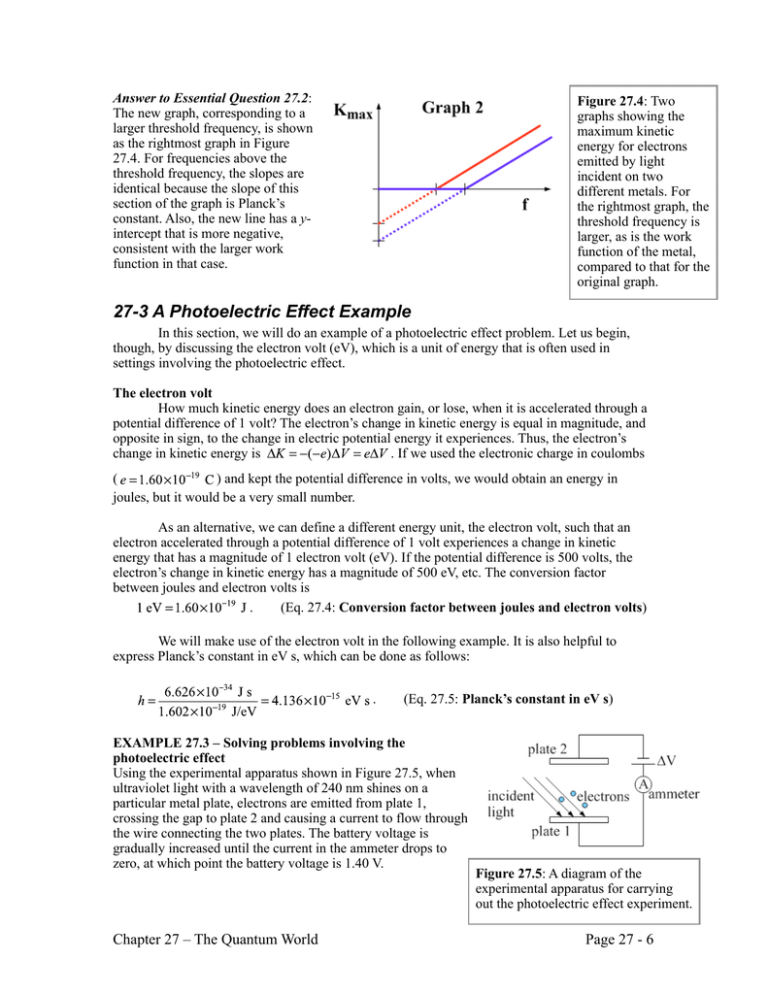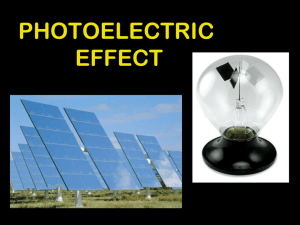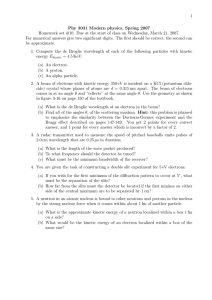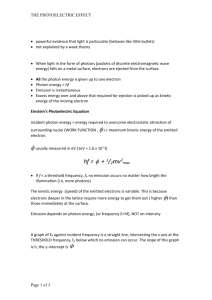27-3 A Photoelectric Effect Example
advertisement

Answer to Essential Question 27.2: The new graph, corresponding to a larger threshold frequency, is shown as the rightmost graph in Figure 27.4. For frequencies above the threshold frequency, the slopes are identical because the slope of this section of the graph is Planck’s constant. Also, the new line has a yintercept that is more negative, consistent with the larger work function in that case. Figure 27.4: Two graphs showing the maximum kinetic energy for electrons emitted by light incident on two different metals. For the rightmost graph, the threshold frequency is larger, as is the work function of the metal, compared to that for the original graph. 27-3 A Photoelectric Effect Example In this section, we will do an example of a photoelectric effect problem. Let us begin, though, by discussing the electron volt (eV), which is a unit of energy that is often used in settings involving the photoelectric effect. The electron volt How much kinetic energy does an electron gain, or lose, when it is accelerated through a potential difference of 1 volt? The electron’s change in kinetic energy is equal in magnitude, and opposite in sign, to the change in electric potential energy it experiences. Thus, the electron’s change in kinetic energy is . If we used the electronic charge in coulombs ( ) and kept the potential difference in volts, we would obtain an energy in joules, but it would be a very small number. As an alternative, we can define a different energy unit, the electron volt, such that an electron accelerated through a potential difference of 1 volt experiences a change in kinetic energy that has a magnitude of 1 electron volt (eV). If the potential difference is 500 volts, the electron’s change in kinetic energy has a magnitude of 500 eV, etc. The conversion factor between joules and electron volts is . (Eq. 27.4: Conversion factor between joules and electron volts) We will make use of the electron volt in the following example. It is also helpful to express Planck’s constant in eV s, which can be done as follows: . (Eq. 27.5: Planck’s constant in eV s) EXAMPLE 27.3 – Solving problems involving the photoelectric effect Using the experimental apparatus shown in Figure 27.5, when ultraviolet light with a wavelength of 240 nm shines on a particular metal plate, electrons are emitted from plate 1, crossing the gap to plate 2 and causing a current to flow through the wire connecting the two plates. The battery voltage is gradually increased until the current in the ammeter drops to zero, at which point the battery voltage is 1.40 V. Chapter 27 – The Quantum World Figure 27.5: A diagram of the experimental apparatus for carrying out the photoelectric effect experiment. Page 27 - 6 (a) (b) (c) (d) What is the energy of the photons in the beam of light, in eV? What is the maximum kinetic energy of the emitted electrons, in eV? What is the work function of the metal, in eV? What is the longest wavelength that would cause electrons to be emitted, for this particular metal? (e) Is this wavelength in the visible spectrum? If not, in what part of the spectrum is this light found? SOLUTION (a) Assuming that the wavelength corresponds to the wavelength in vacuum, we can first convert the wavelength to the frequency using . Now, we can use Equation 26.2 to find the photon energy. . (b) As we discussed in Exploration 27.2, the maximum kinetic energy of the emitted electrons is related to the minimum voltage across the two plates needed to stop the electrons from reaching the second plate (this is known as the stopping potential). In this case, the stopping potential is 1.40 V, so the maximum kinetic energy of the electrons is 1.40 eV. (c) Now that we know the photon energy and the maximum kinetic energy of the electrons, we can use Equation 27.3 to find the work function of the metal. . (d) The maximum wavelength that would cause electrons to be emitted corresponds to the threshold frequency for this situation. Let’s first determine the threshold frequency, f0. . Converting the threshold frequency to wavelength, assuming the light is traveling in vacuum, gives . (e) This wavelength is 329 nm, less than the 400 nm (violet) wavelength that marks the lower bound of the visible spectrum. This light is beyond violet, in the ultraviolet. Related End-of-Chapter Exercises: 13 – 16, 43, 44. Essential Question 27.3: With a particular metal plate, shining a beam of red light on the metal causes electrons to be emitted. (a) If we replace the red light by blue light, do we know that electrons will be emitted? (b) If the two beams have the same intensity and are incident on equal areas of the plate, do we get the same number of electrons emitted per second in the two cases? Assume that in both cases the probability that a photon will cause an electron to be emitted is the same in both cases (e.g., for every two photons incident on the plate, one electron is emitted). Chapter 27 – The Quantum World Page 27 - 7



